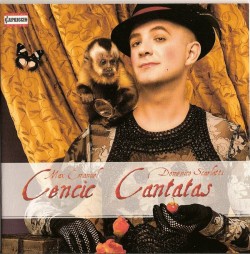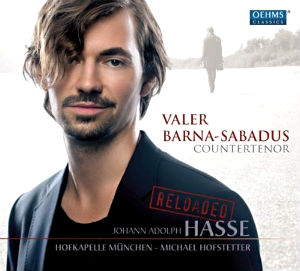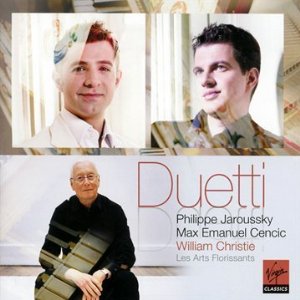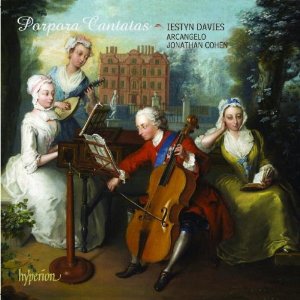The times they are a-changin’! By the end of its 2012-13 season, the Met will have presented four HD transmissions in less than two years (including three new productions) featuring countertenors in prominent roles—an enormous change since 1988, when for the first time in its over one-hundred-year existence a countertenor sang on the Met stage.
While recent Met performances of Rodelinda and The Enchanted Island evoked some fiercely polarized opinions about countertenors, a more mainstream cult for a “guy who sings high” (to borrow the website name of Australian pretty-boy David Hansen) continues to grow, and recording companies accordingly have recently released new CDs by Philippe Jaroussky and Max Emanuel Cencic, Iestyn Davies and Valer Barna-Sabadus.
The complicated history of countertenors and its complex relationship to the extinct castrato phenomenon have always had a relatively specialized following. The countertenor tradition remains strongest in England where men singing falsetto have performed choral church music as far back as the 16th century. The most famous solo music written for the voice comes from the late 17th century by Henry Purcell, a countertenor himself, which might explain why John Blow set his beautiful elegy “An Ode on the Death of Mr. Henry Purcell” as a countertenor duet.
The modern revival of countertenor solo singing began in earnest in Englandin the early 1940s when Alfred Deller was “discovered” singing at Canterbury Cathedral by Sir Michael Tippett who remarked that when he heard Deller sing “the years seemed to roll away”: here, finally, was the voice for Purcell. Tippett must have heard countertenors before, but with Deller he was encountering a special solo artist, one who would go on to an immensely influential concert and recording career. One of the seminal moments in historical performance practice occurred in 1954 when Deller recorded Bach cantatas with the Leonhardt Consort, led by that movement’s towering figure, Gustav Leonhardt, who just died in January.
America’s early pioneer Russell Oberlin differed from Deller claiming he sang with his “natural” voice rather singing falsetto. It’s often this “false”-ness that pundits use to dismiss countertenor singing: “it’s not natural,” etc. Even as acclaimed an artist as Deller had to put up with enormous prejudice in those early days; prominent musicians remarked (presumably in a “stage whisper” meant to be overheard): “I see we’ve got the bearded lady with us!” and “If I got up to sing like that in public my mother would disown me.”
Reading some of the more “colorful” statements online over the past few months commenting on recent Met countertenors reminded me that there are still many listeners out there who just don’t “get” it, so perhaps these singers may remain for many a special case.
The biggest push into the mainstream occurred in the mid-90s with the rise of two “superstars”: David Daniels and Andreas Scholl, accompanied by the conventional wisdom that these two artists manifested unprecedented qualities. While acknowledging their undoubted merit, it would be ingenuous to suggest that they embodied something altogether unprecedented—although I do recall how impressive Daniels was as Monteverdi’s Nerone at Glimmerglass in 1994 and then being moved by Scholl on the Les Arts Florissants “Messiah” recording later that same year.
However, in the years following Deller and Oberlin, excellent countertenors appeared on the scene and became the pioneers that broke out of the cycle of Bach Passions and Handel Messiahs and onto the opera stage in roles usually originated by castrati. Countertenors today also now routinely perform male roles like Polinesso and Arsamene in Handel’s Ariodante and Serse originally composed for women.
Into the world’s opera houses came James Bowman and the much underrated Paul Esswood from England, from Belgium René Jacobs (now one of early music’s foremost conductors) and Jochen Kowalski from Germany, as well as the utterly unique Dominique Visse from France (still going strong at 56).
America produced two of best: Derek Lee Ragin and Jeffrey Gall—the latter in the Handel tri-centenary year 1985 nearly stole the show at Carnegie Hall’s legendary Semele from Kathleen Battle, Marilyn Horne, Rockwell Blake and Samuel Ramey and then dominated Peter Sellars’s revelatory Giulio Cesare which reconceived his title character as a chilling yet romantic neo-Nixonian American President.
In the meantime the male sopranos (as opposed to male alto, sometimes an alternate name for countertenor) occasionally surfaced beginning with American Randall Wong and Greek Aris Cristofellis. Still relatively rare, there are several currently active, including Jörg Waschinski (who just released a CD of music composed by the castrato Farinelli) and Jacek Laszczkowski who also sings as a tenor and whose CD of music by Cesti includes him singing soprano-tenor duets with himself! And the new Naïve recording of Vivaldi’s Teuzzone stars the young Italian sopranist Paolo Lopez in the title role.
Yet that important push into the mainstream continues to assure Daniels and Scholl primacy, as their Met prominence this season shows. Although Scholl remains mostly outside opera (he has sung only three roles on stage), Daniels has had what continues to be an unprecedented career for a countertenor.
Unlike any of his peers, he sings primarily in major international opera houses (Chicago, Covent Garden, Munich, etc.) with orchestras playing on modern instruments—eschewing more specialized productions usually accompanied by original instrument orchestras. This may also account for his startling absence from the continued boom in complete baroque opera recordings nearly always done with HIP forces.
On the other hand, Bejun Mehta (probably America’s other best-known countertenor) is having a very different career from Daniels’s—important recordings and major productions all over Europe, like last month’s revival in Vienna of Gluck’s Telemaco conducted by Jacobs. Mehta always strikes me as the countertenor Vivica Genaux—a huge star inEurope while far less known in his native country, combining awesome stylistic authority and a commanding florid technique with an unsteady, often ugly voice.
The other unusual aspect to Daniels’s career was the concerted effort from the beginning by his management and publicists to create not just a star countertenor but an openly gay one. From the late 90s through the early 00s one couldn’t open a gay publication that didn’t include an interview or profile of Daniels; it turned out to be both a brave and canny strategy, but one that may have influenced the popular misconception that all countertenors are gay. Journalists writing about non-gay singers like Scholl, Lawrence Zazzo and Iestyn Davies always seem to take pains to mention wives, girlfriends, children, etc.
I sometimes suspect this perception plays a part in an audience phenomenon I’ve noticed. Having attended many, many live performances featuring countertenors, I’ve noticed they always seem to get the most applause, even when in many cases they are far from the best singer. This was most clearly demonstrated during a trip to Europe several years ago when I went to several baroque operas; in both Berlin and Venice, terrible countertenors (amid, I must add, otherwise outstanding casts) got huge ovations for their utterly mediocre singing.
My hypothesis is two-fold: there’s still something very exotic and exciting about men singing high music (clearly dating back to the castrati) and many people find it awesome even in cases where it isn’t actually very good. Also perhaps those inevitable raucous ovations arise from an informal claque of rapid gay fans cheering for “the home team?” I do wonder if some conductors pander to that Pavlovian response by always preferring countertenors over mezzos ostensibly on the grounds of dramatic verisimilitude. That would be fine if all countertenors were excellent singers and actors, which many unfortunately are not.
Although a recent puff piece in The Chicago Tribune prior to the opening of Lyric’s current new production of Rinaldo dubbed Daniels “today’s foremost countertenor,” I would argue that the world’s leading countertenors are instead Jaroussky and Cencic, both now in their prime and both currently with contracts with EMI/Virgin although one wonders how this will play out with the recent sale of EMI and the rumored break-ups that may ensue.
In the meantime they have collaborated on a beguiling CD
Duetti, a collection of rare Italian chamber duets by Bononcini, Conti, Benedetto Marcello and Alessandro Scarlatti, along with solo cantatas by Mancini and Porpora. The singers are accompanied by members of Les Arts Florissants: William Christie on harpsichord/organ, Jonathan Cohen on cello and Elizabeth Kenny on theorbo/lute (Hiro Kurosaki and Catherine Girard also show up on violin for several pieces).
One might not have immediately thought of pairing up Jaroussky and Cencic as their voices are so different (and no, all countertenors don’t sound alike nor do they sound like women): Jaroussky’s light, boyish and ethereal versus Cencic’s dark, earthy and dramatic. Yet it is precisely this marked contrast that makes this CD so appealing.
httpv://www.youtube.com/watch?v=woZmdvAhifM
These chamber duets (some complete, some excerpts from longer duo-cantatas) are almost inevitably pastoral, exploring the romantic troubles of shepherds and shepherdesses. Both singers are in top form confidently tackling pieces that range from the entrancingly languorous to the dazzlingly florid. In fact the duets are so consistently compelling that it’s disappointing that nearly twenty minutes of the program is given over to a solo cantata for each singer, particularly since Jaroussky has already recorded many excellent solo CDs on EMI/Virgin and Cencic did four superb CDs of cantatas by Domenico Scarlatti, Caldara and Vivaldi for his previous label Capriccio.
Chamber duets for high voices were very common during the 18th century, and many have already been recorded although I don’t recall any before featuring a pairing of male singers. Usually it’s a soprano and a countertenor as in the excellent four volumes by Monique Zanetti and Pascal Bertin of duets by Caldara, Steffani, Gasparini and Bononcini or the Handel and Steffani disks by Rossana Bertini and Claudio Cavina.
Surprisingly, the note in the Duetti CD booklet gets oddly coy about gender in the pieces programmed. The writer is eager to point out when the characters singing are both male, as in Marcello’s “Tirsi e Fileno” where two rival shepherds bemoan their love for the elusive Clori, but what of Bononcini’s “Pietoso nume arcier” where Aldimira and Dorinda sing of their ardor for Tirsi and Aminta or Conti’s ravishing nightingale duet for Clori and Irene? They are referred to as “two characters” and the dramatic situation simply skirted! This surprisingly skittish approach for a duet CD between two men in 2012 reminded me of a fascinating interview in London’s Telegraph a few years ago when Scholl and Jaroussky were touring an all-Purcell program including
…the duet My Dearest, My Fairest [they are to sing.] This, some of Purcell’s most intense love music, is not usually sung by two men….But, says Scholl, “there is still a discrepancy in perception – we will accept a love duet when two women are singing, but when I sing Dido’s Lament, people say, ‘You can’t do that, it was composed for a woman.’ But, excuse me, women sing the title role of Handel’s Julius Caesar all the time, so what’s the difference? It’s about the humanity of all this music. Apart from our roles and our sexes, we are human beings. There are universal qualities in each of us.”…it’s not about travesty, it’s about humanity. We had Cate Blanchett play Bob Dylan in the movies, and we have Katy Perry singing I Kissed a Girl and nobody has a problem. So why shouldn’t Philippe and I sing a love duet? It doesn’t have to be tacky or ambiguous. If our intention [is] sincere, it can be a great moment. We don’t mean it as a provocation.”
I suspect that Jaroussky and Cencic wouldn’t be bothered at all by possible listener discomfort; after all, they previously played husband and wife in the Les Arts Florissants production of Landi’s Il Sant’Alessio, which featured no fewer than thirteen countertenors!
British countertenor Davies made his Met debut in November as Unulfo in Handel’s Rodelinda and returns there next season for Trinculo in the premiere of Adès’s The Tempest, one of a growing number of contemporary operas with roles written for countertenor. His newest CD
on Hyperion presents six of “12 Cantatas for His Royal Highness Frederick Prince of Wales” by Nicola Porpora composed in 1735; Davies is accompanied by a new group called Arcangelo, led by Jonathan Cohen (the cellist on Duetti).
httpv://www.youtube.com/watch?v=Qmvvanct-U8
Of all the baroque opera composers who seem to be “laying in wait” for a full-scale rediscovery once the current vogue for all things Handel and Vivaldi dies down a bit, Nicola Porpora is a prime candidate. Porpora, whose fame as a singing teacher probably eclipsed his reputation as a composer during his lifetime, wrote more than forty operas which are only now starting to be looked at again.
However, this CD isn’t going to work any wonders for his 21st century reputation. While containing some graceful vocal writing, these cantatas aren’t top-drawer Porpora, nor do the bland, safe performances by Davies and Arcangelo help. A much more convincing case for Porpora and his cantatas comes from the fiery Italian soprano Elena Cecchi Fedi on another Hyperion CD.
However, it would be unfair to dismiss Davies based on this unexciting CD alone. Broadcasts of the Met’s Rodelinda and Lyric’s Rinaldo demonstrated he had no problem at all stealing the show from his senior star colleagues Scholl and Daniels with his appealing confidence and flair. That being said, it’s not a voice I warm to. Though it mercifully lacks the so-called “English Cathedral hoot” common to so many from the UK, the instrument, while exhibiting a stronger middle and lower register than many, remains a bit vinegary for my taste, rather like that of his compatriot Robin Blaze.
Even more worthy of rediscovery than Porpora’s are the operas of Johann Adolph Hasse, a German composer of Italian opera primarily active in Dresden and whose vivid, colorful vocal music is featured in the third and perhaps most exciting of these new CD releases: Hasse Reloaded on Oehms Classics, featuring the young Romanian countertenor Valer Barna-Sabadus (just 25 when this program was recorded) accompanied by the Hofkapelle München conducted by Michael Hofstetter.
Although he was featured in Riccardo Muti’s 2009 production of Jommelli’s Demofoonte in Salzburg and Paris, it wasn’t until he starred as Iarba in Hasse’s Didone Abbandonata last year in Munich that Barna-Sabadus really grabbed people’s attention, and this solo CD was a result (Naxos releases the entire opera later this year).
With a vocal range higher than many of his fellow countertenors, the commanding Barna-Sabadus sails fearlessly through Iarba’s four very demanding arias in addition to a Hasse cantata “La Gelosia” and oddly an aria written by Porpora for insertion into Hasse’s Artaserse. The high point of the CD is the final solo in Didone, “Cadrà fra poco in cenere,” a ravishing, utterly unexpected aria in which Iarba prophesies to Dido the destruction of Carthage but not as a vengeful rejected lover but as someone mourning the upcoming chaos.
httpv://www.youtube.com/watch?v=D1bSZc7lz-U

I recently asked a very opera-savvy friend (but one who doesn’t listen to much music written before the bel canto era) to name five countertenors: he managed only four: all had sung at the Met, all but Scholl American. I don’t think his response was atypical. For many Americans, Daniels remains the countertenor, hence his upcoming Giulio Cesare at the Met (a role he already sang there in 2007), but it’s doubly disappointing after his wan Met Prospero and labored Chicago Rinaldo and because there are so many other fine countertenors today that US audiences rarely hear.

For truly committed countertenor fanatics, EMI/Virgin will release Vinci’s Artaserse later this year featuring Jaroussky, Fagioli, Minenko, Cencic and Barna-Sabadus, the latter two singing female roles created by castrati at the work’s 1730 premiere. Surely more intriguing will be the staging of Artaserse featuring the same singers premiering in (ahem!) Nancy in early November and later touring Europe throughout the fall.








Comments